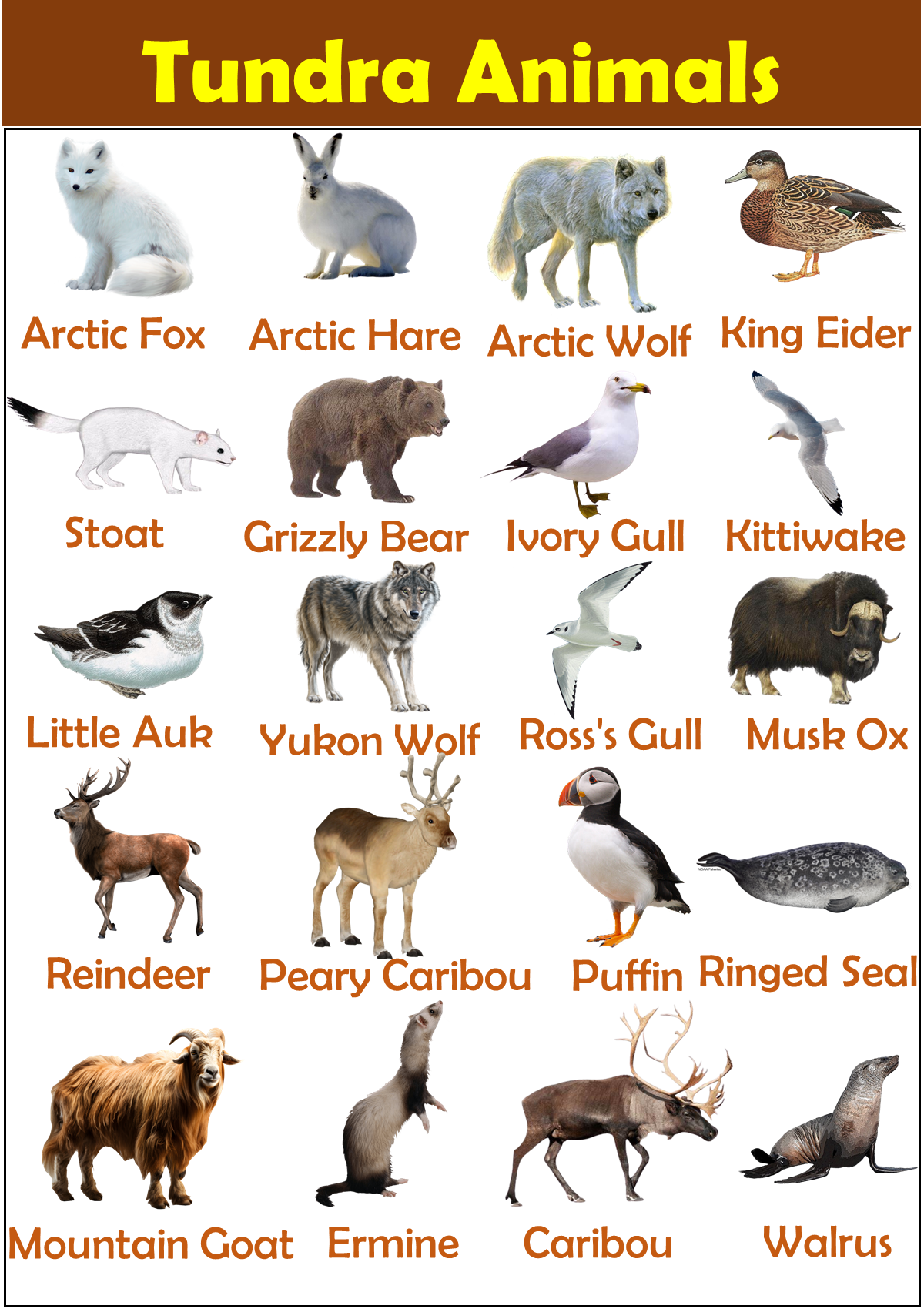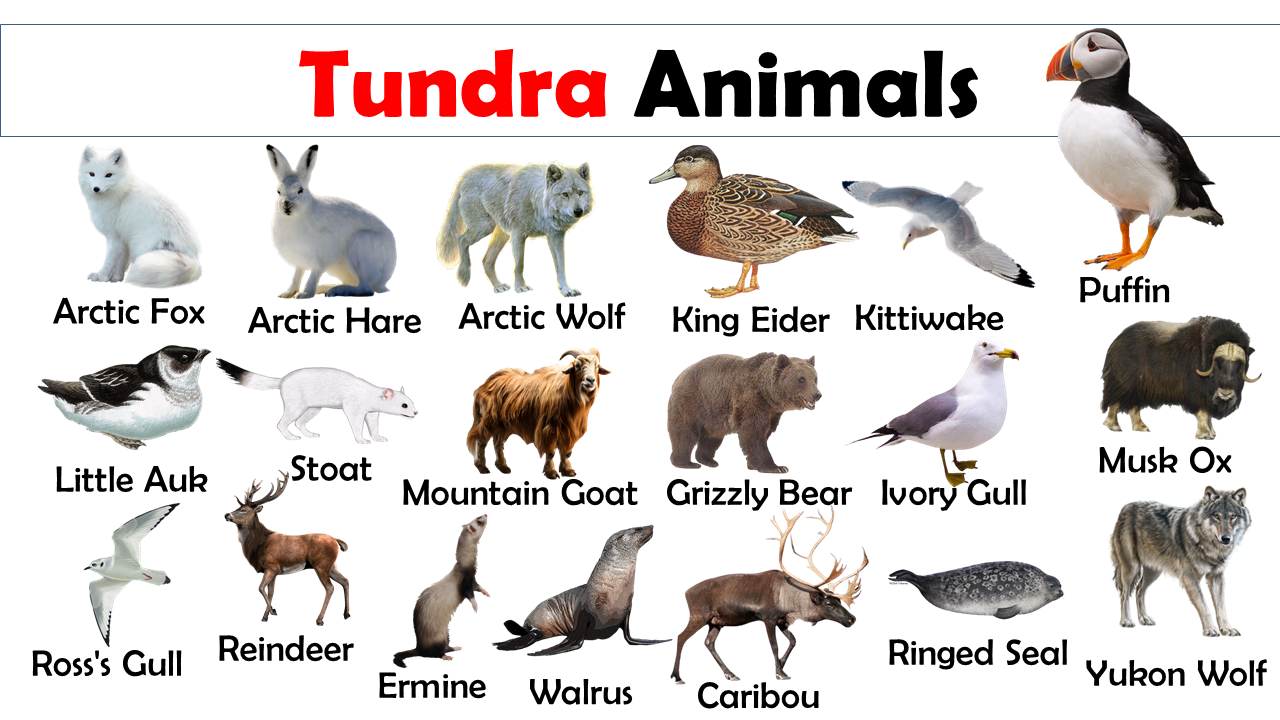The tundra is a cold, windy, and treeless region where only the toughest animals can survive. In this blog post, we’ll discover the remarkable animals that live in the tundra, from the mighty polar bear to the hardy Arctic fox. These animals have special adaptations that help them live in such extreme conditions. You’ll learn about their lives and pick up new English words to describe these fascinating creatures and their chilly home. Let’s explore the incredible world of tundra animals together!
What are Tundra Animals?
The tundra biome is characterized by its cold, arid environment and minimal vegetation. Found primarily in the high Arctic or on mountain tops, this biome supports a surprisingly diverse range of animals that have adapted to extreme conditions. Animals in the tundra have developed specialized adaptations like thick fur, fat layers, and behaviors to survive the harsh winters and enjoy the brief summers.
List of Tundra Animals
- Arctic Fox
- Arctic Hare
- Arctic Wolf
- Beluga Whale
- Caribou
- Dall Sheep
- Ermine
- Greenland Shark
- Gyrfalcon
- Harp Seal
- Lemming
- Musk Ox
- Narwhal
- Polar Bear
- Puffin
- Snow Bunting
- Snowy Owl
- Walrus
- Wolverine
- Ptarmigan
- Red-throated Loon
- Ringed Seal
- Sable
- Sanderling
- Siberian Husky
- Snow Goose
- Snow Petrel
- Snow Sheep
- Stoat
- Tundra Swan
- White-tailed Ptarmigan
- Alpine Ibex
- Alpine Marmot
- Arctic Ground Squirrel
- Arctic Tern
- Barnacle Goose
- Bearded Seal
- Blue Fox
- Canadian Lynx
- Collared Lemming
- Common Eider
- Glutton (Wolverine)
- Great Northern Diver
- Grey Wolf
- Grizzly Bear
- Ivory Gull
- Jackrabbit
- King Eider
- Kittiwake
- Lapland Longspur
- Little Auk
- Mountain Goat
- Mountain Hare
- Northern Fulmar
- Peary Caribou
- Peregrine Falcon
- Reindeer
- Rock Ptarmigan
- Ross’s Gull
- Rough-legged Hawk
- Sabine’s Gull
- Sandhill Crane
- Siberian Crane
- Spectacled Eider
- Thick-billed Murre
- White Fox
- Willow Ptarmigan
- Woodland Caribou
- Yellow-billed Loon
- Yukon Wolf
Explore More Animal Vocab:

Tundra Animals Vocabulary and Their Facts
1. Arctic Fox
The Arctic Fox is adapted to life in extreme cold with its thick, white fur that provides camouflage against the snowy landscape. It eats a varied diet of rodents, birds, and even leftovers from larger predators. Arctic foxes have a keen sense of smell to detect food under the snow.
2. Arctic Hare
Living in the Arctic tundra, the Arctic Hare survives the brutal cold with its thick fur and ability to dig beneath the snow to escape predators. It feeds on woody vegetation and can run up to 40 mph to evade threats, primarily from snowy owls and Arctic foxes.
3. Arctic Wolf
The Arctic Wolf, a subspecies of the gray wolf, is distinguished by its white fur and smaller size. This predator is one of the few mammals that can tolerate the Arctic’s year-round frigid temperatures. It primarily hunts musk oxen and Arctic hares.
4. Beluga Whale
Beluga Whales, known for their distinctive white color and vocal behavior, inhabit Arctic and sub-Arctic waters. They are highly sociable and use a complex array of clicks, whistles, and clangs to communicate and navigate the icy waters.
5. Caribou
Caribou, also known as reindeer in Europe, are well adapted to the tundra with their large hooves that act like snowshoes. They migrate up to 3,000 miles annually, the longest of any terrestrial mammal, in search of food and breeding grounds.
6. Dall Sheep
Dall Sheep are native to the mountains of Alaska. Their stark white coats provide camouflage in snowy environments, and they graze on a variety of vegetation. The males’ impressive curled horns are used in battles for dominance.
7. Ermine
An Ermine, also known as a stoat, sports a white winter coat to blend into the snowy tundra. This small carnivore preys on rodents and birds, and its agility and speed make it a formidable hunter despite its size.
8. Greenland Shark
The Greenland Shark is one of the Arctic’s most mysterious creatures, known for its extremely slow growth and long lifespan, potentially reaching over 400 years. They are top predators and scavengers, often found in very deep waters.
9. Gyrfalcon
The Gyrfalcon, the largest of the falcon species, preys on large birds and mammals. With a striking gray or white plumage that mirrors the tundra landscape, it uses high-speed dives to capture prey, showcasing remarkable aerial agility.
10. Harp Seal
Harp Seals are distinguished by their silvery-gray body and black face markings. They breed on packed ice, where their pups are born with white fur for camouflage. Their diet consists mainly of fish and crustaceans.
11. Lemming
Lemmings are small rodents known for their boom and bust population cycles, which significantly influence the tundra food web. They are crucial prey for many predators and play a key role in nutrient cycling through their digging activities.
12. Musk Ox
Musk Oxen are iconic tundra animals, known for their thick coats and strong social structures. They form defensive circles against predators like wolves. Their underwool, qiviut, is incredibly warm and is shed during the spring.
13. Narwhal
Often called the “unicorn of the sea,” Narwhals are famous for their long, spiral tusks, which are actually enlarged teeth. They are social and primarily feed on fish in Arctic waters. Narwhals use echolocation to navigate and hunt in the dark underwater world.
14. Polar Bear
The largest terrestrial carnivore, the Polar Bear, is directly impacted by climate change as sea ice declines. They rely on sea ice to hunt seals and store energy for the summer. Polar bears are excellent swimmers, a critical skill as their hunting grounds become more dispersed.
15. Puffin
Puffins are seabirds with colorful beaks and excellent diving capabilities. They breed in cliffside colonies and spend the winter in the open ocean. Puffins feed by diving for fish, which they catch with their sharp beaks.
16. Snow Bunting
Snow Buntings are small birds that breed in the high Arctic and winter in temperate zones. They have a distinctive white and black plumage in winter. Snow buntings nest on the ground and can form large flocks during migration.
17. Snowy Owl
The majestic Snowy Owl is adapted for life in the Arctic with its white plumage providing camouflage against the snow. They hunt during the day, feeding mainly on lemmings. Snowy owls can dramatically impact local lemming populations.
18. Walrus
The Walrus is easily recognized by its long tusks and whiskered face. These marine mammals are social and spend significant time on sea ice or rocky shores. They primarily feed on benthic bivalve mollusks, which they detect with their sensitive whiskers.
19. Wolverine
Wolverines are known for their strength and ferocity, far exceeding what their small size might suggest. They are scavengers and predators, feeding on carrion and small mammals. Wolverines have a wide range but are solitary, requiring large territories to support their lifestyle.
20. Ptarmigan
The Ptarmigan, a bird species, changes color from brown in summer to white in winter for camouflage. It survives the cold by burrowing into snow to conserve heat and feeds on twigs and leaves, which are abundant in its environment.
21. Red-throated Loon
The Red-throated Loon is known for its haunting calls and striking breeding plumage. It nests on Arctic tundra lakes and winters along coastlines. Unlike many waterbirds, loons can fly long distances to find suitable water bodies during migration.
22. Ringed Seal
The Ringed Seal is the most common seal in the Arctic, with its distinctive pattern of dark spots surrounded by light gray rings. It is a primary prey for polar bears and has a vital role in Arctic marine ecosystems.
23. Sable
The Sable, a species of marten found in Russia and parts of Mongolia, has valuable dark fur. It inhabits forest environments within the tundra zone, feeding on small mammals and birds. The fur trade has significantly impacted its population.
24. Sanderling
The Sanderling is a small wading bird that migrates from its Arctic breeding grounds to coasts around the world. Recognizable by its frantic feeding behavior along beaches, it probes for marine invertebrates with its beak.
25. Siberian Husky
Originally bred by the Chukchi people in Siberia, the Siberian Husky is robust and built for endurance. They are well-known for their ability to tolerate cold temperatures and their history as sled dogs, contributing to Arctic human settlements.
26. Snow Goose
The Snow Goose breeds in colonies on Arctic tundra and migrates in large flocks to warmer regions in winter. It has two color phases: white and blue. Snow geese are known for causing significant damage to their breeding grounds due to their large population sizes.
27. Snow Petrel
The Snow Petrel is one of the few birds that breed exclusively in Antarctica but migrate to the Arctic. They are pure white with black eyes and beak, feeding primarily on fish oil and krill.
28. Snow Sheep
Native to the mountain ranges of eastern Russia, Snow Sheep are well adapted to cold and rugged terrains. They have thick coats and curved horns, and their diet consists mainly of alpine grasses and herbs.
29. Stoat
The Stoat, or short-tailed weasel, turns completely white in winter except for the tip of its tail which remains black. It is a fierce and versatile predator, feeding on rabbits and rodents, and adapts easily to harsh tundra conditions.
30. Tundra Swan
The Tundra Swan migrates to the Arctic tundra for the breeding season, where it nests on the ground near water. Known for its beautiful white plumage and graceful neck, it feeds on aquatic vegetation and small creatures found in shallow waters.
